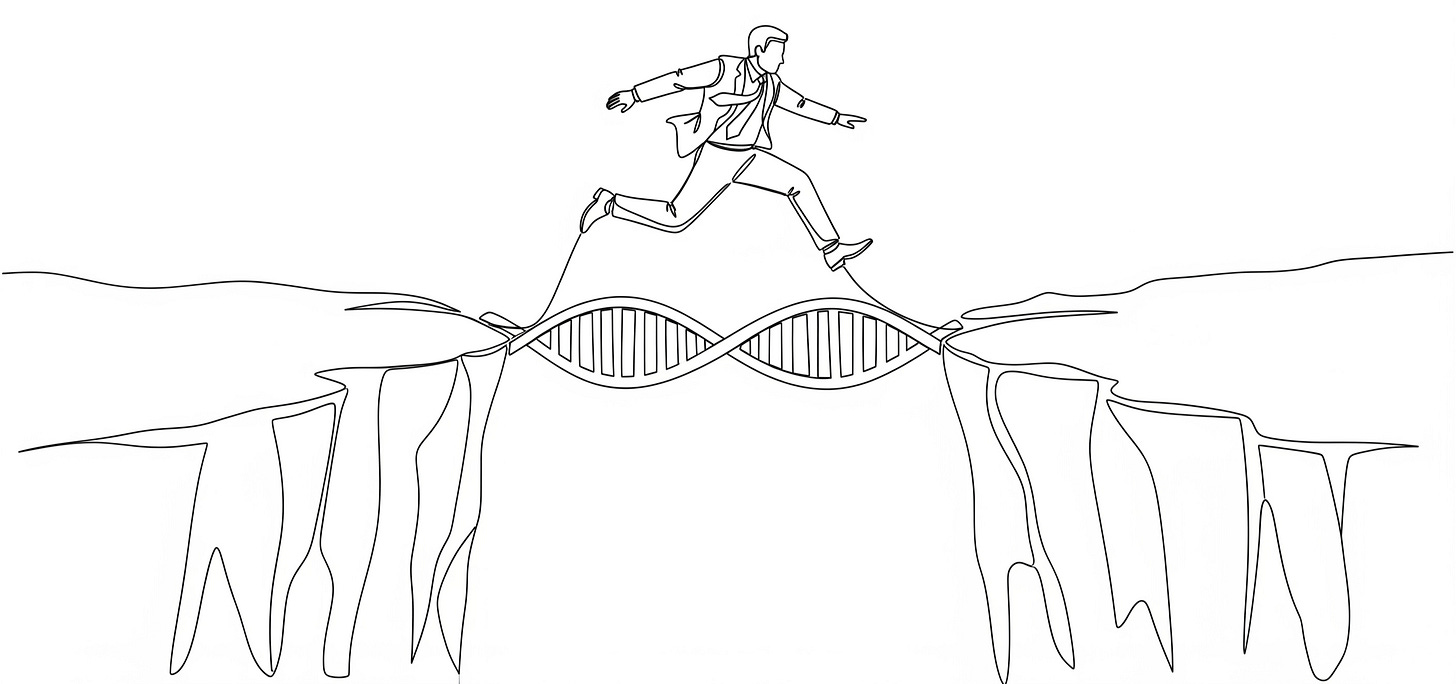Beyond the Precipice – The Great Pharma Patent Cliff and How Precision Medicine & Genomics Can Bridge the Gap
The next 20 years will reward the bold, but who's ready to cross the void?
Over the next few years, the pharmaceutical industry is heading toward a financial drop-off so steep it has earned its own dramatic nickname: the patent cliff.
If you’ve never heard of it, picture a reservoir that’s been filling for years behind a dam. Pharma companies invest huge sums and years of effort to get the water level up – that’s the R&D phase. Once a drug is launched, the floodgates open, and revenue pours through. But the patent expiry is like the dam suddenly crumbling. The flow doesn’t just slow – it surges out uncontrollably, and in months what was once a deep, steady reservoir of income becomes a shallow trickle.
Between now and 2030, more than $200 billion in annual sales is at risk as some of the world’s best-selling drugs lose their patent protection. For a handful of big pharma players, that’s more than a quarter of their revenue disappearing in a few short years.
This isn’t the first patent cliff that the pharmaceutical industry has faced – but it is one of the largest and sharpest in history. And it’s not just a financial story. How companies respond will shape which diseases get attention, which innovations make it to patients, and who dominates the industry in the 2030s and beyond.
Can genomics and new precision medicine approaches bring hope, and new ways to cross the void?
The ticking patent clock
A new drug is typically protected by a patent for 20 years from the date the patent application is filed. That clock starts well before any patient gets access to the medicine.
Developing a drug – from the first promising molecule to regulatory approval – takes 10 to 12 years on average. That leaves maybe 8–10 years of exclusive market time to recoup billions in R&D spending, pay for manufacturing and distribution, and hopefully make a profit.
Once the patent expires, generic manufacturers (or biosimilar makers, in the case of biologics) can launch equivalent versions at a fraction of the cost. Prices crash, market share erodes, and brand-name sales often drop by 80% or more within months.
A company that once earned billions each year from a single drug can find that revenue reduced to a rounding error on its quarterly report almost overnight.
Why the cliff is here now
The wave we’re about to hit is the result of blockbusters launched in the early 2000s and 2010s – many of them transformative in their fields – all reaching the end of their exclusivity at around the same time.
📊 The Coming Patent Cliff — By the Numbers
Global sales at risk (2024–2030): ~$200 billion
Average patent life: 20 years from filing
Average time to market: 10–12 years (leaving ~8–10 years of exclusivity)
Typical sales drop post-patent: 80% or more within months
Top drugs losing exclusivity soon:
Eliquis (BMS/Pfizer) - $13B annual sales - patent expiry 2026
Keytruda (Merck) - $29.5B annual sales - patent expiry 2028
Opdivo (BMS) - $10B annual sales - patent expiry 2028
Humira (AbbVie) -$21B peak sales - US exclusivity ended 2023, biosimilars now launched
Ibrance (Pfizer) - $4.7B annual sales - patent expiry 2027
Why it matters:
Huge loss of revenue in a short period
Pressure to fill pipelines fast
Shift toward late-stage programs with higher probability of success
Opportunity for precision medicine to de-risk earlier discovery
The late-stage safety net – and its limits
When faced with this kind of shortfall, it’s tempting for pharma companies to double down on late-stage development programs. After all, Phase 3 trials are expensive but the probability of success is far higher than in early discovery. You might get a new revenue stream in 3–5 years instead of a decade.
The problem is that if everyone focuses on late-stage assets, the early pipeline dries up. And without early discovery, you have no late-stage candidates 10 years from now. The industry risks becoming like a farmer who stops planting seeds because they need to sell crops immediately.
Enter precision medicine
Fortunately, we now have tools that can make early discovery and late-stage development both faster and more likely to succeed. Genomic evidence, deep mechanistic insights, and patient stratification biomarkers can help us:
Identify the right targets earlier
Match them to the right patients
Avoid costly failures in Phase 2 or 3
Move successful drugs to market faster
One of the most compelling stories of this in action comes from AstraZeneca.
The Tagrisso turnaround
What sounds like it might be a mid-90's dance move, is in fact an excellent example of precision medicine done well - shout out to
for bringing it to my attention. 2003, AstraZeneca launched Iressa, an EGFR-targeted therapy for non-small cell lung cancer. Expectations were sky-high. But the drug underperformed and, within two years, it was pulled from the US market.Instead of abandoning the program, AstraZeneca doubled down on the science. Researchers identified a subset of patients with specific EGFR mutations who responded dramatically to treatment. That insight – a classic example of precision medicine – laid the groundwork for Tagrisso, approved in 2015.
Fast forward to 2024: Tagrisso generated $6.6 billion in global sales, accounting for 12% of AstraZeneca’s total revenue. It’s now a backbone therapy for EGFR-mutated lung cancer across early-stage, locally advanced, and metastatic disease.
Tagrisso wasn’t just a win for patients. It was proof that genomic and mechanistic insights can rescue a failing program and turn it into a blockbuster.
Beyond oncology
While oncology has been the poster child for precision medicine, it’s also one of the most crowded spaces in pharma. If companies want to avoid hitting another cliff in the 2030s, they’ll need to look beyond cancer to other areas where:
The unmet need is massive
The science is complex
Historical attrition rates are high
CNS and neuroscience are prime candidates. Alzheimer’s, Parkinson’s, depression, schizophrenia – these are conditions affecting millions, yet treatment options are limited and often only modestly effective. Failures in these areas have been common and costly, but that’s exactly why they need a new approach.
Precision medicine could identify molecular subtypes of these diseases, find predictive biomarkers for treatment response, and match patients to therapies more effectively. It’s the same playbook that worked in oncology – just applied to some of medicine’s toughest challenges.
More time on the clock
There’s another benefit to getting the right drug to the right patient faster: more time on market under patent.
If precision medicine can shave years off clinical development by showing clear efficacy in a targeted population, companies can win back valuable patent life that would otherwise be lost to trial delays or failures.
Even after launch, stratification biomarkers and genomic insights can support new label claims, fresh patents, and targeted subpopulation indications – effectively extending the commercial life of a drug.
The next 20 years will reward the bold
Here’s the hard truth: not every company will survive the patent cliff intact. Some will patch the hole with in-licensing deals or acquisitions, others will scramble for short-term wins and still see revenue slide.
But the winners – the ones dominating 2035’s revenue tables – will be the companies that:
Invest in early discovery rather than abandoning it for short-term safety
Use genomic evidence, mechanistic insights, and biomarkers to de-risk programs early
Diversify beyond oncology into high-need, high-complexity disease areas
Leverage precision medicine not just to improve success rates, but to accelerate time to market
This isn’t about chasing one or two mega-blockbusters. It’s about building a pipeline of precision medicines across multiple therapeutic areas, creating a steady flow of impactful, high-value drugs for decades to come.
Signal over noise.
Thanks for reading Signal Over Noise.
If you made it all the way here, either you’re deeply interested in the subject or you’re just too polite to stop scrolling – either way, I’m grateful.
If you think this piece is worth sharing, please do. It helps get these ideas in front of the people who can actually do something with them (or at least argue with me about them in the comments).
You can subscribe for free to get future posts direct to your inbox. No spam, no pop-up ads for shoes you never wanted, just science and stories I hope are worth your time.
And if you’ve got thoughts, questions, or the irresistible urge to tell me I’m wrong, jump into the comments – I read every one.
All content on Signal is free and open-access. The bill is paid in curiosity.



